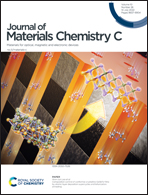Exploring novel ligands with strong electron delocalization for high-performance blue CsPbBr3 perovskite nanoplatelets†
Abstract
Colloidal CsPbBr3 perovskite nanoplatelets (NPLs) with readily controllable thickness are considered promising blue-emitting materials. However, the relatively low photoluminescence quantum yield (PLQY) and poor stability hinder their further applications. Herein, a class of novel surface ligands, such as 2-butynoic acid (BtA), phenylpropiolic acid (PA) and 2-pentynoic acid (PtA), are proposed for conveniently preparing high-performance blue-emitting NPLs. Benefiting from the strong electron delocalization effect of alkynyl, the protonated amine species (RNH3+) and R–C![[triple bond, length as m-dash]](https://www.rsc.org/images/entities/char_e002.gif) C–COO− prefer to coordinate with the perovskite, which can not only enhance the PLQY of NPLs from ∼15% to ∼100%, but also promote their endurability to high temperatures and strong UV irradiation. To our knowledge, this is the first report on the post-treatment of perovskites with electron delocalized ligands containing alkynyl and the effect of electron delocalization of Lewis bases on high-performance NPLs is systematically investigated from the perspective of molecular structure, which will be helpful to develop novel short-chain and conjugated ligands for perovskite electroluminescence devices.
C–COO− prefer to coordinate with the perovskite, which can not only enhance the PLQY of NPLs from ∼15% to ∼100%, but also promote their endurability to high temperatures and strong UV irradiation. To our knowledge, this is the first report on the post-treatment of perovskites with electron delocalized ligands containing alkynyl and the effect of electron delocalization of Lewis bases on high-performance NPLs is systematically investigated from the perspective of molecular structure, which will be helpful to develop novel short-chain and conjugated ligands for perovskite electroluminescence devices.



 Please wait while we load your content...
Please wait while we load your content...